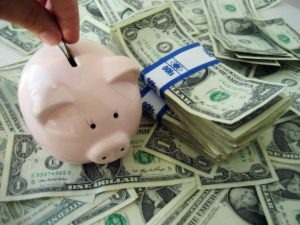Remember Malaysia Airlines Flight 370?
The passenger airplane that crashed into the Indian Ocean in 2014? It killed all 239 people on board, leaving little to no debris behind. It’s the second deadliest crash involving a Boeing 777, and the deadliest crash in Malaysia Airlines’ history.
This came after Flight 17 was shot down over the Ukraine-Russia border.
2014 was a pretty terrible year for Malaysian Airlines.
Executives wanted marketing to come up with a brilliant idea
Malaysia Airlines was already struggling financially before Flight 370, which only made things worse. Bookings were down by 60 percent; the majority of their customers refused to fly with them.
They needed to repair their image.
They needed marketing to step in with a brilliant idea and save the day. This would give them the ability to stop the financial bleeding and restore public confidence.
And their brilliant idea?
They launched a promo called “My Ultimate Bucket List Contest.”

You read that right.
The same company that had two brutal crashes, killing 537 people, was now asking new customers to plan for their death.
With them.
Their “brilliant” idea needed work
When we read stories like these we shake our heads and wonder, “What were they thinking? Why didn’t someone say something about this? How did this get past legal?” Stories like these do significant damage, alienating customers and partners.
But there’s something worse than a bad idea.
It’s having no idea. It’s the inability to come up with a brilliant or effective marketing idea when you need it. It’s a common problem that most of the internet struggles with. When you browse through content on the internet what do you find?
Noise.
Distracting, underwhelming, completely forgettable noise.
As marketers, it’s our job to attract attention and convert customers, whether that’s an opt-in, sign-up or sale. That’s the problem though, isn’t it?
What do you do when you’re fresh out of ideas?
The best ideas rely on a framework
Most people believe this myth – either you’re an idea maker or you’re not. There’s no in between according to many naysayers. That sounds true.
But is it?
No, not so much. Certain marketing teams are able to consistently generate brilliant ideas, whether they’re creating a content marketing, advertising or video campaign. In fact, the channel doesn’t really matter. They’re able to create something brilliant
How, you ask?
Start by becoming fascinating.
We’re all familiar with AIDA
I know, I know marketing 101. Cue the groans and eye rolling. It sounds condescending but stick with me I’m going somewhere with this.
Okay.
The first A in AIDA – attention right?
How many of us know the framework for creating and attracting attention, on demand? What do we need to create the best ideas ever? Sure, we get pieces of the puzzle – a tip here, a strategy or tactic there. But they’re just puzzle pieces. They don’t give us a complete picture.
Fascination is how you get attention. Not only that, when it’s used well it’s immediate.
What do I mean by “fascination?”
Sally Hogshead reached out to Kelton, a market research firm, and asked for help. She gave them one goal.
Find what fascinates people.
Kelton researchers found there are seven basic facets to fascination.
- Alarm screams consequences, danger, and loss. It’s the screeching tires flooding your body with adrenaline, the Hell’s Angel parked next to you, and the serial killer roaming around your city.
- Mystique, at its core, is about curiosity. It’s puzzles, unanswered questions, bait pieces, and unsolved mysteries. It’s alien abductions and DB Cooper. The Bermuda Triangle and Tamam Shud.
- Passion is emotional; it’s intuitive, expressive, and animated. It’s the Occupy movement and divisive issues. Cosplay enthusiasts and collectors. Groupies and band geeks.
- Power is about control. It’s a command over people, circumstance, and self. It’s the man with the gun, people with leverage, and military might.
- Prestige says “I’m better than you.” It’s one-upmanship using symbols of hierarchy, rank, and achievement. The luxury car signaling affluence, your coveted award, and the backstage pass.
- Rebellion is the forbidden fruit. The alluring drive pushing us into the realm of innovation and taboo. Donald Trump’s potty mouth and his in-your-face behavior. Body modification and shock rock.
- Trust is reliable, predictable and consistent. It’s about knowing what to expect and the safety and comfort of routine. It’s a pristine track record and consistent performance. Warren Buffett and Amazon One Click.
When you’re fascinating people give you their attention immediately. customers, competitors, colleagues – they can’t help but stare.
These psychological cues are how we attract attention
It’s an intrinsic part of human nature. We use these skills everyday whether we like it or not.
But what does this look like?
Alarm
This ad turns the runway into something that’s in your face and horrifying… Which is exactly what Amnesty International wants to do.

Mystique
The Sailing Stones are rocks that move themselves across the desert, with no intervention. How do they do it? Somebody knows.

Passion
Terry Crews uses passion about music and muscles to attract customers to Old Spice. Not once do they pitch customers. But four years later, people are still sharing the ads.
Power
3M is so confident in their product that they’re willing to use it to keep you from getting their 3 million dollars. Power at it’s finest.

Prestige
Audi, BMW, Mercedes and Bentley routinely compete for customer attention. And they do it by one-upping each other mercilessly.

Rebellion
Russian Tampax ads go against cultural norms, using taboo to grab your attention.
Trust
The Toyota Tundra used videos to establish enter the competitive truck market. They used demonstrations to increase trust dramatically.
See what I mean?
When we’re fascinated, when our attention is hooked by anything at all, these psychologically triggers are in play.
The best ideas begin with great source material
The best ideas don’t reinvent the wheel. Create ideas that are too far ahead of their time and your audience won’t appreciate it. Tie those ideas to something they relate to and viola, Instant attraction.
Let’s say you’re looking for ways to create fascinating content.
You want people to actually read your content. You know the more time they spend with you the more likely they are to convert. How do you make that happen?
It’s simple.
You create a framework and you follow your process.
You can use this process for pretty much anything. All marketing depends on content so you can use this for blog posts, ads, sales content, scripts, etc.
Step 1: Save and tag content

You’ll want to save source material and inspiration resources; you’ll also need a system to tag and track them so they’re easy to find later. The keywords you use aren’t as important as using them consistently. Consistency matters more and more as your collection grows. Whenever I need a story, idea, or statistic, I look through my collection first.
Here’s a list of the tools and resources you’ll need as your brainstorming session gets started.
- An account with Pocket, Del.icio.us, Xmarks or your tool of choice.
- Google alerts and a list of trigger keywords.
- A starter list of sources.
You’ll want a mix of similar and dissimilar sources you can use to brainstorm new ideas.
Step 2: Setup your tools

Trying to keep track of the ideas you receive from your information sources is a lot like drinking from a fire hydrant. There’s simply too much information to keep track of.
You’ll want to take the time to set up your tools properly.
If you’re using Google Alerts, you’ll want to create a list of broad trigger keywords. For example, let’s say you’re an electronics retailer and you sell digital SLR cameras. Using the alarm trigger we’ve discussed you can create a short list of broad keywords.
- Camera recall
- Camera sensor
- Autofocus fail
- Nikon DSLR error message
- Canon’s ERR99
- Shutter release error
You’re looking for keywords that will help you keep track of the changes happening in your industry. You can create a short list of keywords for each of the triggers you have in mind. Brand names, model names, it’s all fair game. You’ll want to set things up in Google Alerts so you’re notified whenever anything happens with any of your keywords.
Okay, you’re ready to save the notifications you’ve received. How do you do it? I use Pocket as my tool of choice because it’s easy. Easy gets done.
When it comes to saving content I use three distinct categories.
- Story. I tag everything in this category with the keywords “story” and “stories” if it’s a fascinating story I save it for later.
- Research. Statistics, data, research studies – I save with the “research” and “data” tags. I use these tags for any quantitative data I find.
- How to. Tutorials, how to articles, instructions, directions all get tagged with the “How to” and “tutorials” tags
I use these tags first, then I add any content or subject specific tags afterwards. Doing this will help you find and sort through content you’ve saved quickly.
Step 3: Create a starter list of source material

You’re looking for at least one source for per trigger but I’d recommend three or four to get started. A single source can cover more than one trigger.
Here’s a list of sample sources for…
Alarm
- Vice.com
- Breitbart
- Vox.com
Mystique:
- Quora
- OddityCentral
- Digg/
Passion:
- TED talks
- Digg
Power:
- New York Times
- The BBC
Prestige:
- Harvard Business Review
- New York Times
Rebellion:
- Vice.com
- Vocativ.com
Trust:
- Time Magazine
- The Economist
If you’re looking to create the best ads ever you’ll need ad sources. Looking for ways to write the best content ever? You’ll need content sources and so on. I’ve included content sources here but you can take this in any direction you need to.
You’ll also need to have a list of standby or general sources. These standby sources can be anything from single page websites offering very specific information to information clearinghouses like Smart News, Facebook, Google Trends, Alltop and other sites that don’t fit neatly into a specific category.
Step 4: Browse, read and consume information

Okay.
You’ve created your own list of information sources. What’s the next step? You follow them and read their stuff.
Browse and read through content, consume as much information as you’re able to handle. Take the time to learn and grow. This shows you what everyone else is doing and it keeps you on top of your game. This is an important step that many marketers do their best to avoid.
That’s a huge problem, here’s why.
There’s a direct correlation between the information you have in your head and the amazing ideas you’re able to come up with. You want to create the best ideas ever, taking in fascinating content isn’t optional.
Learning is not optional.
Here’s why.
When you run into a roadblock, when you’re fresh out of ideas and you’re feeling stuck, it’s a sign that you, your marketing team, is malnourished.
That’s okay.
Most marketers are malnourished.
Imagine that you’re asked to run a marathon. You’re given a sponsor, professional grade equipment, the best trainers, etc. If you win, your sponsor agrees to give you $300K, tax free. Sounds awesome, right?
Just one catch.
You’re not allowed to eat or drink for 20 days before the race and 20 days after.
Still doable?
For most humans on planet earth, the answer is No.
Most marketers are running a marathon without “food.” Running a marathon without eating or drinking makes no sense.
You’re no different.
Brainstorming, doing your best to come up with the best ideas ever, makes no sense if you’re creatively and intellectually malnourished.
Because you can’t give what you don’t have.
You need mind food.
Step 5: Steal and rob others shamelessly
Kirby Ferguson, a New York filmmaker, created the series, everything is a remix showing that all “original” material builds off of or remixes material that came before it.
We’re all copy cats.
Everything we create is based on or influenced by someone else’s work. Here’s the interesting thing his research revealed. All-star creators used a simple formula to create the best ideas ever.
Copy, transform, combine.
Famous marketers like Albert Lasker, David Ogilvy, Claude Hopkins – all of the greats used this formula. In fact, influencers, game changers and thought leaders use this formula to create something great.
I’m using it in this article.
This is how the greats churn out amazing idea after amazing idea.
- They Copy. You look at what others are doing; you study it, you look at it from different angles. Then you reproduce it.
- They Transform. The greats add their personal touch, their preferences, experience and flourishes. They modify and tweak the details they’ve copied. They turn them into something else, a derivative work.
- Then they Combine. They combine their transformations, they merge them together with something new. In the end they’re left with something compelling and completely new.
With this system, creative malnourishment becomes old news. Teach this structure to your team and you’ll begin to see their skill grow. You’ll begin to teach each other as your skills begin to compound.
Ignore the system and your skill slowly fades away.
The amount of time it takes to lose your skill is directly proportional to the time it took you to develop that skill. Because everything fades away in time.
What if your ideas aren’t the best?
That’s a good question, isn’t it? What makes ideas the best? Being the best is subjective. It depends almost entirely on context.
Batman vs. Ironman
Pepsi vs. Coca Cola
Apple vs. Android
You can argue about who’s best forever. But there’s an easy way to solve the dilemma.
Ask the right people.
Your audience decides what’s best. The deeper your relationship with them, the better you know them, the clearer best becomes.
Your audience decides, and you deliver.
Malaysia Airlines didn’t have the best idea
They were faced with an uphill battle and extreme disaster. Their ideas fell apart. They didn’t listen to their audience, to their customers. They listened to the wrong people.
They were malnourished.
But you don’t have to be. Brainstorming for marketers doesn’t have to be a disaster. You have a system; an idea generator that teams like yours can use to create the best ideas ever.
Amazing becomes the norm, when you have the right system. The look and feel is different but the results are the same.
Legendary.




